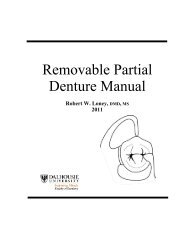Manuals_files/CD Manual 12.pdf - Removable Prosthodontics
Manuals_files/CD Manual 12.pdf - Removable Prosthodontics
Manuals_files/CD Manual 12.pdf - Removable Prosthodontics
You also want an ePaper? Increase the reach of your titles
YUMPU automatically turns print PDFs into web optimized ePapers that Google loves.
Wax Try-in - 64<br />
Sibilant sounds (‘S’, ‘Z’‘T’ ‘CH’ ‘SH’, ‘sixty-six’, ‘Mississippi’) - upper and lower<br />
incisors should approach end to end relationship<br />
Fricative sounds (F, V, ‘Fifty-Five’ , ask patient to count from 50 to 60) - upper incisal<br />
edges should just touch the posterior one third of the lower lip<br />
7. Denture base contours<br />
Denture base contours can affect phonetics, comfort and retention. In general, the<br />
denture bases should not be convex in shape.<br />
Remove excess wax to provide room for tongue if you note the patient struggling with<br />
phonetics, or noting that they do not have enough tongue space. Ensure that the denture<br />
base is not unduly thick or thin. Excess bulk will impair comfort, and a base that is too<br />
thin will be structurally weakened.<br />
8. Patient Input<br />
At any point in the try-in appointment, ask for patient input, using open ended questions<br />
(“How do you like the appearance?” rather than “Don’t the new dentures look great?”).<br />
If the patient sounds unconvincing in their approval of the setup, attempt to get more<br />
information by asking further questions. Do not let the patient dissuade you that the wax<br />
try-in stage should be rushed in the interest of saving time.















